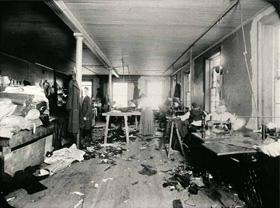Notes on Some Trades in which Women are Employees (excerpt)
Page 277
CLOTHING (WOMEN'S WAISTS)
Location of Buildings
New York city (sic) is the greatest center of the women's waist trade in the United States. The 228 shops inspected were on Manhattan Island, south of 35th street, (sic) in the most congested portion of the city. Ninety-one per cent of the establishments inspected were located in loft buildings, and of the 11,000 odd workers in those shops, one-half were employed above the sixth floor. This overwhelming proportion of loft shops is characteristic of all branches of the clothing trade in New York city (sic). The Asch fire disaster of last March threw a lurid light on the fearful risks to the workers involved in such a situation.
Condition of Work Places
It is remarkable that a very large percentage (62 per cent) of the waist shops inspected used artificial light in the daytime, while 60 per cent had no protection from glare - this, too, in a trade where proper lighting would seem to be a prime necessity for efficient, accurate work, to say nothing of the effect of such inadequate illumination on the eyes and health of the workers.
A larger percentage (28 per cent) of extremely dirty shops were found than in any other trade employing over 50 per cent of women workers, with the exception of the artificial flower and feather industry. Thirty per cent of the water closets were in a filthy condition and had no light or ventilation whatever.
Page 278
Processes of Manufacture
The waist trade has had many vicissitudes of late years, owing to changes in the market, and many shops that formerly made only waists now make waists and dresses, either together or as supplementary trades. The processes do not differ greatly from the other branches of the clothing trade. Men are always employed to do the cutting of the materials, and a small proportion of men operators is found in some of the shops, particularly those making the cheaper grades of waists and dresses. Women are employed at the different branches of operating; such as lace running, tucking and machine button-holing, and also as finishers and hand button-hole makers. In making the cheaper grades of waists, the subdivision of processes is carried very far, and a waist may pass through the hands of a dozen workers before it is finished. This "section work" is nearly always piece-work and requires very little skill, speed being the prime necessity. The better grade of waists and dresses, however, cannot be made in this way, and one girl will make the whole garment, or a large part of it. Such workers are usually paid by the week, since greater skill and carefulness are required.
Dangerous and Unhealthy Elements in the Trade
In common with the other branches of the clothing trade, the dangers to the women workers are not inherent in the industry itself, but are due to the conditions under which manufacture is conducted. The hazards of death or injury from fire that must be daily assumed by the women worker in loft factories on Manhattan Island are terrific. But the overcrowding of work rooms, long periods of overtime, with irregular daily schedules, running from ten to fourteen hours, with consequent over-fatigue and exhaustion, the speeding up of both workers and machines, which keeps nerves and muscles in continued tension, are factors that from day to day seriously impair the health and vitality of the women workers. No amount of cleanliness and convenience in the work rooms can offset the injurious effects resulting from long, irregular working hours and nervous strain.
New York (State) Factory Investigating Commission, Preliminary Report of the Factory Investigating Commission, 1912, 3 vols. (Albany, New York: The Argus Company, printers, 1912), 1:277-278.

